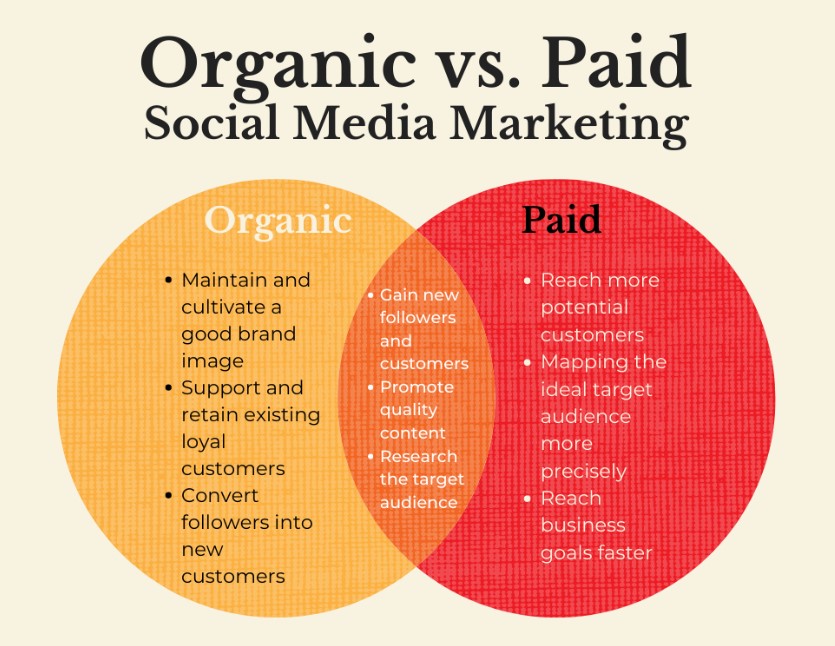
We’ll begin by distinguishing between paid social and organic social. The distinction is straightforward: organic social content is provided for free. Paid social material is posted with the intent of reaching a wider audience by spending money to do so.
Organic social postings will appear in the News Feeds of those who already follow you on social media. Due to the fact that your audience shares and interacts with your content, more people will see them.
Regardless matter whatever demographic you choose to target with your ad, your paid social posts will appear in their News Feeds. You may target audiences based on their demographics, geographic location, interests, and other characteristics.
It is also possible for the worlds of paid and organic content to collide. For example, you may pay to have an organic post “boosted” in order to get it in front of more people. Using this method for organic articles that are doing really well is typically a successful tactic.
Identifying organic social phenomena
Following our discussion of the fundamentals of organic and sponsored social media, let us turn our attention to organic social media in further detail. In this part, we’ll discuss the importance of publishing organically on social media, as well as the sorts of material that should be shared. In addition, we’ll discuss some strategies and best practises for sharing organic social content on various social media platforms.
WHY SHARE ORGANIC SOCIAL CONTENT ON THE INTERNET?
“Do I want to reach current customers or new consumers?” should be the first question you ask yourself when preparing to launch a new video or other piece of content on social media. If you want to target current clients who are already following you on social media, organic should be your best bet for success.
In addition, it is crucial to realise that your organic postings are grouped together to make what amounts to a social website. They provide credibility to your company in the eyes of prospective consumers who are contemplating whether or not to do business with you–and more and more people are turning to social media to learn about products and services they are interested in.
A total of 58 percent of customers who responded to study of 1000 consumers said that they first visited a brand’s social media accounts before visiting their website. And it is an increase of 81 percent over the previous year. These customers will see the organic material that you have published on your social media networks when they visit your pages.
BEST PRACTICES FOR ORGANIZING ORGANIZATIONAL POSTING
Are you prepared to publish organically? Keep these excellent practises in mind as you go about your day:
Reduce the number of promos you run. Keep the sales pitch for your advertisements. Instead of concentrating on convincing individuals to make a purchase, concentrate on offering material that your followers and prospects will find useful. Organic content may be used to tell stories, educate, and inspire people. Of course, it’s never a bad idea to throw in a special promotion for your most loyal customers every now and again. The promotional material, on the other hand, should be interspersed with meaningful information that will help viewers come to know you, trust you, and feel connected to you.
Make the most of your individuality. While you’re reducing sales speak and promotions, take advantage of the chance to demonstrate your personality. Show off the individuals behind your firm, your corporate values, and your hobbies as a brand by showcasing them on your website.
Strengthen the image of your company. To continue on the topic of branding, your organic content provides an excellent chance to enhance your brand identity. What is it that you want others to know about you? Take a look at your social media accounts to see if any of those characteristics are reflected in your present material. Instead, develop material that highlights what you do and what you stand for as a company. Make sure it’s prominently displayed at the top of your social media accounts.
Recognizing the value of paid social
When using organic social media, you just publish and wait for things to occur. Paid social media, on the other hand, ensures that you will be noticed. As we go through this part, we’ll look at the advantages of launching sponsored advertising on social media. In addition, we’ll provide some pointers and best practises for sponsored social advertising.
Getting started with sponsored social media might be intimidating for new business owners, but it can be a terrific method to build brand recognition, drive visitors to your website, and create sales. It does need a bit more expertise than the organic side of things, but it is a talent that is well worth having on your resume.
Boosting, which we’ll discuss in more detail in the next section, is a simple approach to test the market. However, if you want greater control over your ads—as well as better results—we suggest that you use Facebook Ads Manager. More information on how to utilise Facebook Ads Manager may be found in our guide.
WHY SHOULD YOU INVEST IN PAID SOCIAL MEDIA?
The number of customers who make purchases as a result of viewing advertisements on social media is increasing. It has been reported that, in the last year, 24 percent more customers purchased anything as a result of viewing a sponsored social advertisement than they did the year before.
Business owners are taking notice of and investing in this increasing success with social commercials. According to our poll, 96% of marketers have reported spending advertising dollars on videos, and 91% are happy with the return on their social video marketing investments.
SOCIAL MEDIA ADVERTISING RULES AND BEST PRACTICES
For further information on maximising the effectiveness of your social advertising strategies, consider the following suggestions:
Make sure you’re talking to the proper people. What is it about social advertisements that makes them so effective? The selection of targets! When the appropriate message is combined with the proper audience, tremendous results may be achieved.
Make a clear call to action to your audience. Include a strong and obvious call to action in your video if you want viewers to know what you want them to do next (CTA). You should urge them to “purchase now” if you want to increase sales. You might even provide a limited-time special deal to make the situation even more urgent.
Keep it to a minimum. Your social advertisements will be featured in the Feed for those who may not be familiar with your brand and who are not actively searching to connect with material from your company, such as those who follow you on social media. In order to avoid this, it’s critical to make your video or message concise and to the point. Communicate a message that will connect with the audience you’re trying to reach–and do it as soon as possible. We suggest that video advertisements be kept to a maximum of 15-30 seconds in length.
Always be on the lookout for bugs. If you don’t succeed the first time, keep trying. To optimise your results, test alternative message, different visuals, and different calls to action to see which ones work best.



